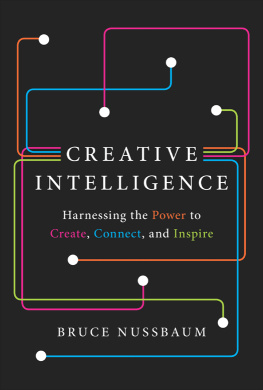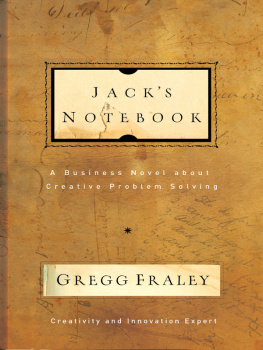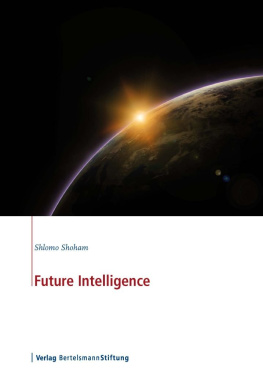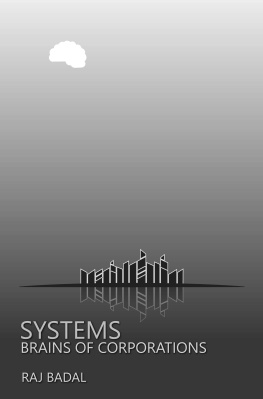
For Leslie
w.d.m.
W HEN I WAS AT BusinessWeek, I was happy to make the transition from being a voice of authority, editing the editorial page and writing cover stories, to a curator of conversations, managing online innovation, design websites, and blogs. This book puts me back into a voice of authority role, but that would not have been possible had I not also participated in many conversations about creativity, innovation, and design. It is my hope that this book will, in turn, spark many new conversations that I can participate in. Of course, I am solely responsible for Creative Intelligence, but I am also deeply indebted to many people for its creation.
Let me start with Ben Lee, former provost of the New School and professor of Philosophy and Anthropology. Creativity is often a product of proximity and connectivity, and had I not been given an office near Bens when I moved to Parsons The New School for Design, this book would not exist in its current form. I developed many of the books key concepts, especially those revolving around the social context of creativity, in wonderfully stimulating talks with Ben. His graduate work at the University of Chicago in anthropology, economics, and philosophy meshed with my graduate work at the University of Michigan in anthropology, sociology, and political science. While co-teaching courses, such as Steve Jobs and Alexander McQueen: Design as Social Movement and Design, Capitalism, and Social Movement, I honed many of the arguments made in this book. Ben has a curious, insightful, and inspiring mind, and I was just plain lucky to find myself sharing the same water cooler, literally, with him.
Parsons is a special place, drawing exceptional students from Asia, Europe, Latin America, the Middle East, and, of course, the United States. I spent a year working with a student named Kelsey Meuse before she graduated on a proposal for a Gen-Y research institute. Students from the Design and Management; Art, Media, and Technology; and Design and Communications programs have been particularly wonderful to work with. Their team projects have led to insights that are reflected in my discussions on embodiment, aura, and knowledge mining.
Special thanks go to the grad students in the MFA Fashion and Society program run by Shelley Fox. A designer herself, Shelley teaches not only the craft but also the political sociology of fashion. Carlos Teixiera, who, like me, is in the Parsons School of Design Strategies, shared with me his amazing research on the rise of new innovation and design consultancies in India, Brazil, and other emergent countries. I am grateful to Carlos for looping me into the Dream:In conference in India that shaped the way I view creativity today. And it was Carlos who introduced me to Sonia Manchanda and Jacob Mathew, cofounders of IDIOM, Indias premier innovation firm, and organizers of the first Dream:In conference. By creating opportunities for those at the bottom of the pyramid to dream better futures for themselves, Sonia has become the intellectual heir to C. K. Prahalad.
Cities are the cauldron within which most innovation and creativity take place, and the dean of Parsons, Joel Towers, has helped me understand the complexities and opportunities within the urban ecosystem. Urbanism in all its forms plays a huge role at the New School, to which Parsons belongs, and there is a deep domain knowledge about cities resident on campus. It has helped sustain the work Ben Lee and I have been doing in mapping creativity in New York with our students. Jane Jacobs would be proud of the New Schools approach to cities.
I first met Keith Sawyer at a conference called Creativity, Play, and Imagination at Teachers College, Columbia University, in May 2011, but one of my students had already recommended his book, Group Genius, months before. Sawyer is one of the giants in the field of creativity, and his research underpins many of the stories we read about the subject in the popular press. I am indebted to him for shining a light on the origins of modern creativity research and for showing the different strands of thought that flow together into the field today. In covering innovation and design at BusinessWeek, my knowledge of creativity came from a different source and traditionproduct and industrial design. While the focus on human factors in design led to the same anthropological and sociological sources of insight as creativity, there were also differences. Keith Sawyers work was key in helping me bridge those differences. In his work and his personal life, playing jazz piano and doing improv on stage, Keith has lived a most creative life.
I owe a huge debt to the design community as a whole for providing me with a series of mentors to teach me about innovation and creativity. My first cover story on design was called Smart Design, and I wrote it before I knew that there was a top design firm in New York City with that name. The cofoundersDan Formosa, Davin Stowell, and Tom Dairhave helped teach me what constitutes good design. Another cofounder, Tucker Viemeister, has taught my class about the close connections between design, creativity, and progressive education.
One of the first product design articles I wrote for BusinessWeek some twenty years ago was about the Woodzig, a small rotary saw designed by Ziba Design. I still use that wonderful tool, which fits perfectly in my hand. As the field of design has evolved from a simple focus on product to include a more complex concentration on strategy, Sohrab Vossoughi, founder of Ziba, has become one of the worlds top advisors to corporations. Sohrab always says good design comes from having good clients, and Ziba has great clients.
David Kelley, Tim Brown, and Bill Moggridge have been key tutors in my learning about design, innovation, and creativity. David is not only a cofounder of IDEO; he founded the extraordinary d.school at Stanford. He and Tim are on the cover of what is probably my most impactful cover story, The Power of Design. David, Tim, and Bill believed that design should go beyond the physical to include the design of experiences, services, and even social systems, such as health and education. They codified that approach into the concept of design thinking, the scaffolding upon which Creative Intelligence is built. When Bill Moggridge took over the leadership of the Cooper Hewitt National Design Museum, I got to know the humor and grace of the man who designed one of the first laptop computers and fathered the field of interaction design. I will miss him.
There is only one dean of a business school that I know who would say, If you cant measure it, it might be the very most important thing about your business. That would be Roger Martin, former dean of the Rotman School of Management at the University of Toronto. Much of my work has been in the intersection of business and innovation and design, and Roger is simply the most sophisticated and provocative thinker in that space. And his critiques of financial capitalism are nothing short of heroic.
The list of extraordinary people in design and innovation that I have met and learned from includes, in alphabetical order, Paola Antonelli, Banny Banerjee, Yves Behar, Robert Blaich, Robert Brunner, Bill Buxton, Allan Chochinov, Beth Comstock, Sam Farber, Lee Green, Ric Grefe, Ronald Jones, John Kao, Larry Keeley, Anna Kirah, Claudia Kotchka, Nick Leon, Tom Lockwood, Sam Lucente, Patricia Moore, Dev Patnaik, Chee Pearlman, Jeneanne Rae, Paul Saffo, Bob Schwartz, Craig Vogel, Harry West, Patrick Whitney, and many others.
One of the untold stories of innovation is the role
Next page





